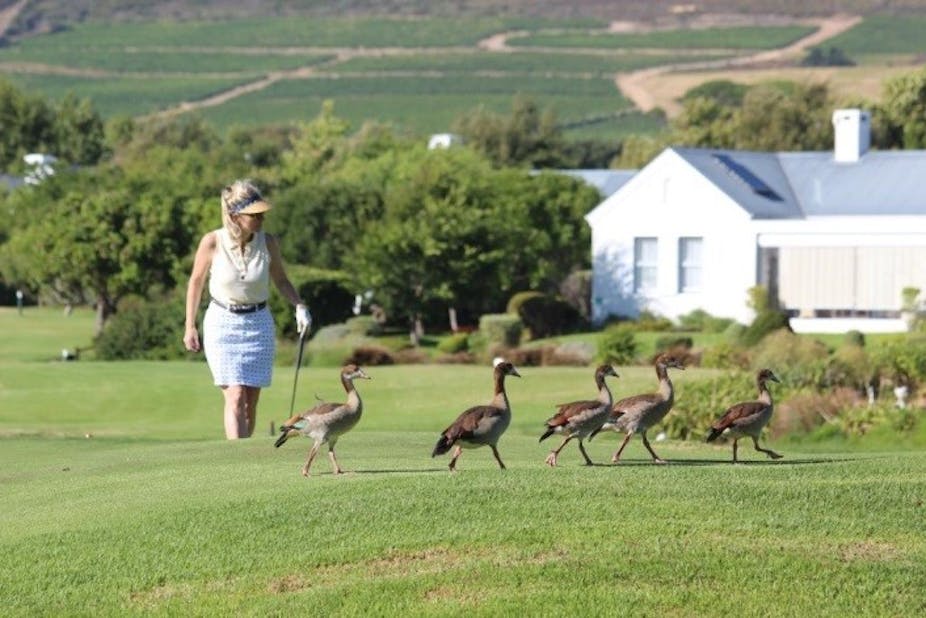It’s not just golfers who enjoy spending a day on the course. Geese are also drawn to their luscious, irrigated lawns interspersed with artificial water bodies. There are also no predators lurking in the bunkers. Contrary to their specific name, where they appear in ancient Egyptian art, Egyptian Geese are widespread throughout Africa from the Nile River down to South Africa. They are common in most landscapes, except for regions of extreme aridity and high altitude.
The birds’ fondness for golf courses isn’t considered a problem until their presence starts ruining the lawns. In South Africa, Egyptian Geese are the problem, just as Canadian Geese wreak havoc on North American golf courses.
There are more Egyptian Geese in South Africa than before. This is because of burgeoning cereal production and dam construction in the coastal Western Cape province. Since these birds aren’t going away any time soon, it’s important to examine what’s best for both them and golf courses.
The geese need management
There are 106 golf courses in the Western Cape, providing geese with almost 5 000 hectares of attractive habitat. Researchers asked residents of Cape Town’s Steenberg Golf Estate and members of its golf club about their perceptions of the ubiquitous feathered visitors.
Most golfers (84%) considered geese a problem on the estate. But only 57% of non-golfers perceived the geese as a problem. People ranked the problem as minimal (15%), moderate (33%) and severe (52%). Most golfers (87%) felt that the goose population required active management. The majority (86% of all respondents) believed the goose population should be reduced by 50% or more.
There are lethal and non-lethal ways to control geese. Non-lethal methods have included scarecrows, fake predators, flashing lights, bird alarms and fireworks. Most have had little success because the geese soon become used to their presence.
Trained herding dogs have proved to be more successful. But dogs are expensive to buy, need expert training and cost a lot to look after. Relocating geese to new habitats is also not foolproof because the birds may return to the site of capture, or will begin novel conflicts of crop damage or being a general nuisance in other areas.
Lethal measures include egg addling by puncturing or chemically treating eggs and culling. But the high mobility of the geese make both quite ineffective for controlling localised populations.
In addition when geese abandon unsuccessful nests, they typically make a new one and thus a replaced clutch. Shooting geese in residential areas is considered unethical, and while lethal methods are more cost-effective than non-lethal options, they are often deemed socially unacceptable.
While it is not necessary to eliminate geese from a property, managing their numbers at a level where they are tolerated by managers and golfers may be important.

Possible solutions
Researchers looked at finding possible solutions from two angles. First they studied how geese behave, where they are most comfortable and where they feel most threatened. Secondly they matched this with the layout and physical features of 10 golf courses in the Western Cape.
This was done to better understand what makes the courses attractive to the geese. Geese avoid predators by being vigilant and by scanning the landscape for any possible threat.
Geese are obviously more vigilant where there is an increased possibility of being caught by a predator.
They seem to feel safer in precisely the areas where they and their droppings bother golfers most: on open patches of green close to water. In these spaces, the birds seem to feel there is less risk of encountering a predator. They can see at a good distance around them and take refuge in the water if threatened.
The answer is for golf course management to shift their focus away from the birds and to the way golf courses are designed. They could, for example, reduce the number of favoured sites. Alternatively, favoured sites should be shifted to the non-playing areas of the course. Areas where water bodies are adjacent to large, open lawns could be avoided in the design of a course.
Poorly situated ponds on existing courses could be modified with physical barriers to restrict access to the water. These barriers can be fences along the edge of the water or a wire grid placed over the water surface. The most inexpensive and attractive method is to plant vegetation along the edge of the water. This would interrupt the geese’s access to the water and decrease their ability to detect predators.
Considering that large patches of open lawn are attractive safety features for geese, tall grass and shrubs can also be planted around the fairways of existing golf courses. This will reduce the openness and the safety levels perceived by the geese.
Or there is falconry. By introducing a predator into the landscape, falconry is effective at changing the perception of safety for the geese. This method naturally involves a few goose deaths, but the birds then quickly learn about the potential threat. They increase their vigilance and become less attracted to the course.
According to our research it is indeed possible for humans and geese to occupy the same territory peaceably. Designing golf courses and adjacent vegetation so that they are attractive to local bird species while simultaneously being less attractive to Egyptian Geese involves short-term costs with potential long-term benefits.

